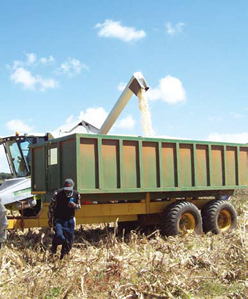Hermetic Storage Technology
 How it Works:
How it Works:
Once closed as per instructions provided, oxygen and other gases are prevented from entering or exiting the bag thus protects the dried grains and pulses from infestation damage that most commonly occurs during post-harvest storage.
The key precaution is to ensure stored grains and cereals are dried to the recommended moisture levels (13.5%) before storage.
Recommended crop for storage using HST: Maize, beans, cow peas, green grams, sorghum, millet, chic peas, and many other cereals.
Availability: In Kenya, the HST bags are available in more than 600 AGDs across Kenya and Tanzania.
Monolayer vs. Multilayer Liner
The hermetic storage technology (HST) bag consists of an inner liners and a woven polypropylene (WPP) outer bag for protection.
There are two technologies for the manufacturing of HST inner liners:-
The multilayer which consists of 5 or more layer co-extruded and blown with multiple compounds and joined together to form one super strong inner liner. It gives the best hermetic property in terms of oxygen transmission rate (OTR) and the bag strength. This is the latest technology and the HST bag requires just one multilayer liner to be effective.
Benefits of using the HST bags
Better Margins: Hardworking farmers and their families do not have to sell the grains and pulses in a hurry at the time of harvest and get the minimum prices, but store them in the HST bags and sell them later as the market prices go to increase their margins.
No loss of weight during storage
There is no moisture grain or loss when dried grains and pulses are stored in the HST bags, which normally happens in WPP bags and farmers lose 4 to 5kgs in weight per bag.
Financing Security & Stronger future
These addition margins would make the farmers economically strong to pay the school fees for their children, medical expenses of the family and funds to get seeds & inputs for the next season. Most small farmers are forced to sell their produce at the time of harvest at less process where’s they could sell the same after 3 to 4 months by storing in HST bags thus ensuring over 67% increased revenue from sale of their stored produce. Farmers also get better market acceptance by the buyers if their grains are not treated with pesticide dust and are not infested.
 Food Security
Food Security
Farmers can store their grains at home without any worries of post-harvest damages and use their harvest when they need for their family, instead of buying from shops at a higher price later. It would revive the granary concept, back at home, that seems to have extinct with the small hold farmers over the years.
Food Safety:
Since no pesticides are for storage, food prepared from these grains and pulses do not affect the health, hence, provides a healthy body and therefore a healthy mind.
Shelf Life:
The HST bag can be used for a minimum of three seasons, which is much below the cost of pesticide dust and the repeat dusting required in 3 to 4 months for the post-harvest storage.
Precaution before use:
The cereals and pulses should be dried to the recommended moisture content for storage purpose. The harvest should also be cleaned and sorted well e.g. to remove stones and other materials such as wood splinters or crop residues which could damage the liner, before storing in the HST bag and the inner liner should not be perforated or damaged when acquiring it or before reuse.
The bags should not be washed or perforated. There should be no addition of any pesticide dust to the grains stored in the HST bag. Store the bags in a cool, dry place and wherever possible, preferably on a pallet. Avoid exposure to direct sun. If the grains are already treated with pesticide dust before storage, expose them to sunlight till; the pesticide dust effect is minimized and then store them into the HST bag.
Rodents:
Normally the rodents do not attack the HST bags as the grains scent is sealed off when bags are secured tightly. Rodents are likely to attack the bags if the bags if the grains are spilled on the floor, therefore, the room where the grains are store, the doors, windows & eaves must be secures well with a wire mesh. Natural repellants are recommended for use to keep rodents away.
Price:
In Kenya the HST bag is available to the farmers at KES 250/- for 100kg and KES 150/- for 50kg.
Hermetic Storage Technology Bags are available in Tanzania to the farmers at TZS 4,500/- on an average, across the country.
Instructions to use:
- Place the HST Bag together with the inner liners.
- Pour little quantity of grains and adjust the bag to remove any folds.
- Fill with 100kg/ 50kg of the grains to be stored up to 2/3rd of the bag.
- Remove all air pockets from the top of the liner.
- Twist the remaining part of the inner liner, bend the twisted inner liner part and close it using a smooth tie.
- The outer bag is also closed in the same way as the inner liners with a smooth tie.
- Store the closed bags on- farm in a cool and dry placed preferably on a pallet.
- The room must be secured from rodents by using mesh on the windows and ventilators.
- When preparing to sell, remove the grain and pulses from the HST bag and pour into WPP bag of 90kg or 50 kg for transporting into the market.
- Fold the empty HST bag and keep safety for the use in the next season.